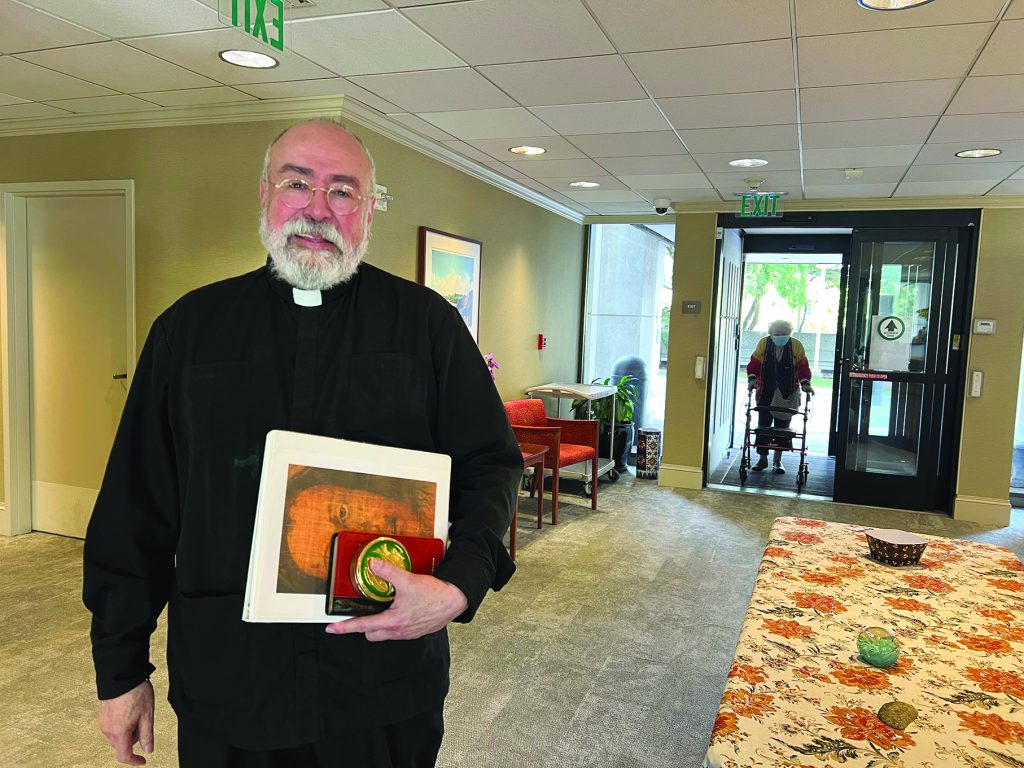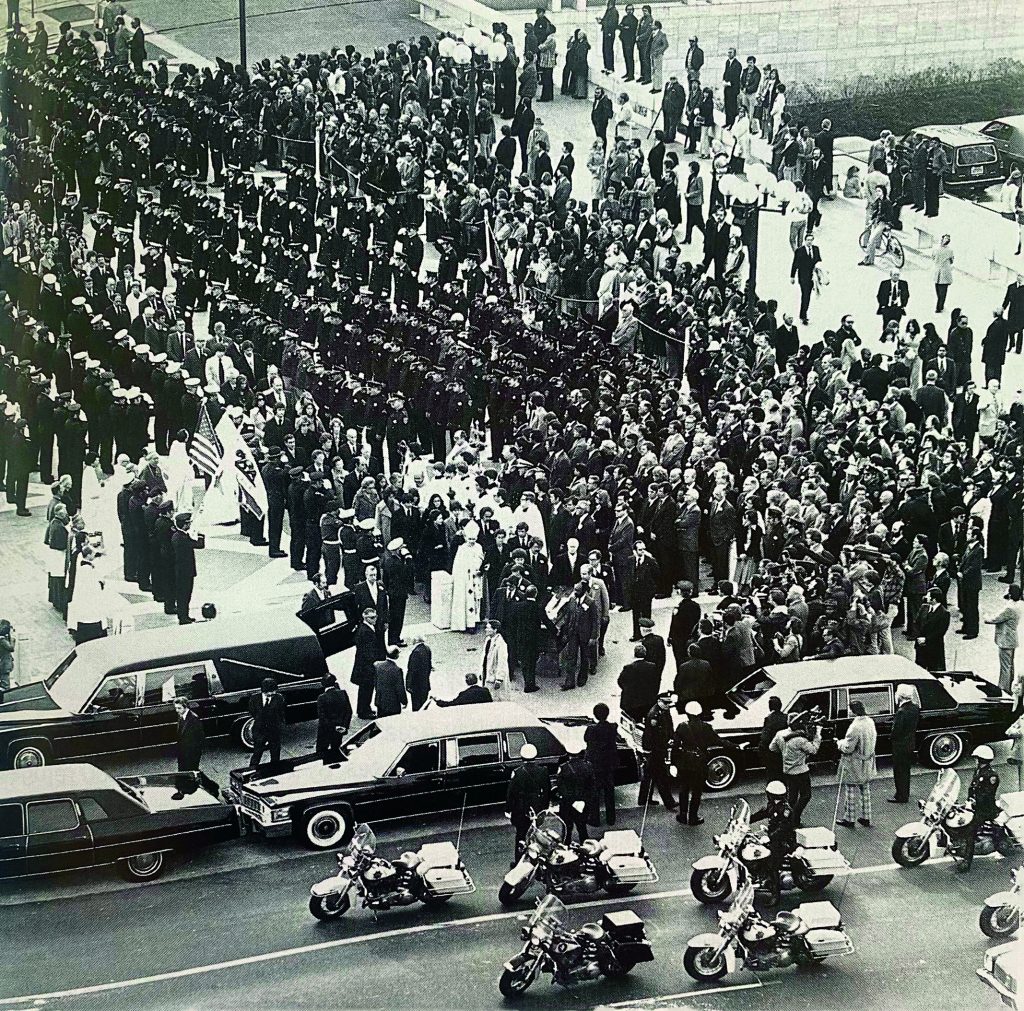Boundless Faith:
Heart of multi-cultural parish beats inside (and outside) cathedral
By Christina Gray
Lead writer, Catholic San Francisco
Father Arturo Albano’s responsibilities as rector of St. Mary’s Cathedral seem as towering as the holy dwelling for which he was chosen caretaker.
He manages the cathedral’s daily operations, its staff, maintenance and security, and the money that pays for it all. But he’s also a pastor, supporting the spiritual care of not only members of the parish, but those on its periphery – the homeless, tourists, downtown office workers and the sick and homebound living nearby.
“It’s a big responsibility to me to project and protect the mother church of the archdiocese,” said Father Albano. Appointed rector seven years ago after serving Mission Dolores in the same capacity, he is the ninth rector in the last 50 years of the Cathedral of St. Mary of the Assumption.

The first rector of the “new” St. Mary’s was Msgr. Thomas J. Bowe, from 1962-1981. Other past rectors have included Father Patrick McGrath (retired bishop of San Jose) and Msgr. John Talesfore, now pastor of St. Matthew Parish in San Mateo.
Like many an attentive father, Father Albano spends the final minutes of each day double-checking the locks on the doors of his cathedral home — despite a full-time security detail.
The beloved cathedral is a strikingly public symbol of the Catholic Church in San Francisco. Over the years it has weathered repeated acts of protest and vandalism.
At his installation Mass homily in 2015, he broadly defined his priorities with the letter L.
“Lights, locks, leaks, liturgy and love for the people of God,” he said. “This church built on a hill is very symbolic of the faith of the people. It rises up.”
THE PARISH COMMUNITY — THEN, AND NOW
The cathedral parish population has utterly changed over the past 50 years, according to Deacon R. Christoph Sandoval, one of two deacons along with Deacon Juan M. Michel. White Catholics, primarily of Irish, Italian and German descent, were the largest Catholic ethnic groups in San Francisco when the cathedral broke ground in 1965.
“Today, our cathedral is a multicultural parish,” he said. “The diversity of the people here is huge.”
In terms of active, registered parishioners, the 2021 Mass count determined a population of about 700 for St. Mary’s Cathedral. But the number is not an accurate picture of those seated in the pews on any given day.
Some Massgoers live nearby, within traditional parish boundaries. But many, if not most, do not. They come from other San Francisco neighborhoods, like the Tenderloin or Mission District, or from across the Bay. Catholics registered as parishioners at other parishes in the archdiocese can make up a portion of the congregation, too.
The Latino-Hispanic (Mexican American and Central American) community is by far the largest and fastest-growing parishioner base at the cathedral, according to parish staff. Asian Pacific Islanders, primarily Filipino, Chinese, Japanese and Vietnamese Catholics, make up the second largest group of parishioners, along with a smaller, but sizeable number of Africans, African Americans and Native Americans. ›
“The 11 a.m. Sunday Mass used to be our biggest Mass, hands down, for years,” said Deacon Sandoval. “No more. Now, it’s the 1 p.m. Spanish-language Mass.” It attracts 400 people and more each Sunday.
The multicultural parish is reflected in its hosting of major archdiocesan annual events, including the annual Chinese New Year Mass of Ancestors; the Filipino Advent novena, Simbang Gabi; and the African American Gospel Jazz Mass. The largest of these is the “Pilgrimage of Love” organized by La Cruzada Guadalupana de San Francisco (which was founded at the cathedral). The annual procession dedicated to Our Lady of Guadalupe started in 1994. Thousands process 12 miles from All Souls Parish in South San Francisco to the Our Lady of Guadalupe Shrine at St. Mary’s Cathedral, while praying the rosary. There they lay flowers at her feet.
The Latino-Hispanic community is “very vibrant here,” with a large music ministry and children’s religious education program, according to Father Albano.
Among his other duties as assistant pastor, Father William Nicholas is in charge of adult faith formation. The program has been conducted mostly online since his arrival to the cathedral at the onset of the pandemic.
“As a parish, the cathedral is different than any other parish out there,” he said. It functions as a cathedral, and “is not really a regular parish.”
Father Albano said a young adult program has been hard to get off the ground in recent years. Much of his outreach to this age group has been on an individual basis inside the cathedral.
“They wander up here from their high-tech jobs downtown,” he said, seeking something they don’t find there.
PARISH COMMUNITY GOES “BEYOND THE PEWS”
“It’s not just about 1111 Gough St.,” said Deacon Sandoval about the parish community. It goes “beyond the pews,” he said.
Every week, he and cathedral priests alternate responsibility for bringing the Mass, sacraments and their presence to the sick and homebound residents of more than 20 nearby nursing homes and senior care facilities. Among them are those who may have once come regularly to Mass at the cathedral or other local parishes, but are no longer able to.
They range from San Francisco Towers on Pine Street, which serves wealthier residents, to Palm Residential Care Home in Hayes Valley, serving the poor.

“As far as I’m concerned, all the people to whom we minister are our parishioners,” he said.
The deacon described a visit two years ago to the memory care unit of Coventry Place, a senior care facility on Sutter Street. He arrived to a room full of residents, listing in their wheelchairs in varying stages of diminishment from the ravages of dementia.
“When I started to chant, ‘Our Father, Who Art in Heaven,’” he said, “all of a sudden they came to life, slowly rising up like flowers responding to the warmth of the sun.” Some started chanting the prayer themselves.
Deacon Sandoval leads the cathedral’s four other unique spiritual care support ministries, which are free and open to anyone. They include a monthly spiritual support group for people facing life-threatening illness, a monthly grief support group, and a healing ministry. He is also coordinator for the cathedral’s Traditional Latin Mass, appointed by the Archbishop.
During the coronavirus pandemic, the cathedral started a cathedral crisis prayer help line, soliciting prayer requests and phone support for those afflicted by the virus, those grieving the loss of a loved one or those having a hard time coping with isolation and fear.
“Our focus is to address human suffering; that’s it,” he said. “We do it through the sacraments, and we do it through hands-on ministry.” ›
A PARISH TO SAN FRANCISCO
In recognition of the cathedral’s 50th anniversary, San Francisco Mayor London Breed issued a proclamation on Oct. 1, 2021, recognizing St. Mary’s long legacy of contribution to the city itself.
“San Francisco is proud to thank the Cathedral of St. Mary of the Assumption for serving the wider community at the funerals of those struck down in the line of duty, including Mayor George Moscone and many police officers and firefighters with its bishops, priests and deacons offering spiritual comfort and consolation to civic leaders, families and friends in their time of grief and bereavement,” it read, in part.

The eight-point proclamation also recognized the cathedral’s designation by the Department of Emergency Management as a Red Cross disaster center place of sanctuary and support. It also recognized the cathedral’s lower-level Event Center meeting and banquet rooms as a major municipal center for “critical meetings of government, dialogue sessions for policymakers and training seminars,” among others.
San Francisco is renowned for its homelessness problems. During the colder winter months, the cathedral’s lower level is converted each night into a refuge for unhoused men the San Francisco Interfaith Winter Shelter. The cathedral’s St. Vincent de Paul conference joins with other parishes and people from other denominations to support the shelter which houses and feeds shelter guests.
In the proclamation closing, the city recognized the cathedral for “offering spiritual refreshment and charitable assistance to the thousands who have crossed its threshold from nations around the world.”

